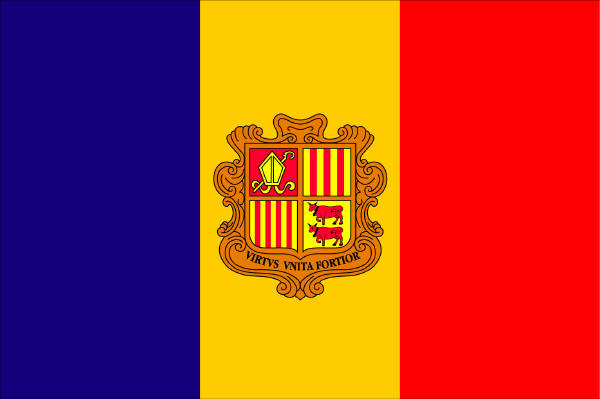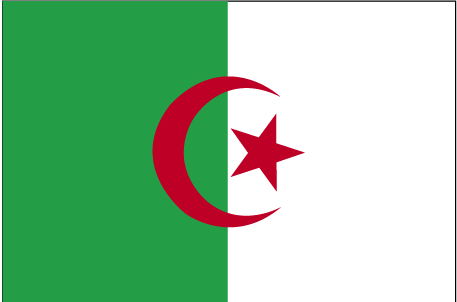Location:
Northern Africa, bordering the Mediterranean Sea, between Morocco and Tunisia
Geographic coordinates:
28 00 N, 3 00 E
Map references:
Africa
Area:
total: 2,381,741 sq km
country comparison to the world: 10
land: 2,381,741 sq km
water: 0 sq km
Area - comparative:
slightly less than 3.5 times the size of Texas
Land boundaries:
total: 6,343 km
border countries: Libya 982 km, Mali 1,376 km, Mauritania 463 km, Morocco 1,559 km, Niger 956 km, Tunisia 965 km, Western Sahara 42 km
Coastline:
998 km
Maritime claims:
territorial sea: 12 nm
exclusive fishing zone: 32-52 nm
Climate:
arid to semiarid; mild, wet winters with hot, dry summers along coast; drier with cold winters and hot summers on high plateau; sirocco is a hot, dust/sand-laden wind especially common in summer
Terrain:
mostly high plateau and desert; some mountains; narrow, discontinuous coastal plain
Elevation extremes:
lowest point: Chott Melrhir -40 m
highest point: Tahat 3,003 m
Natural resources:
petroleum, natural gas, iron ore, phosphates, uranium, lead, zinc
Land use:
arable land: 3.17%
permanent crops: 0.28%
other: 96.55% (2005)
Irrigated land:
5,700 sq km (2003)
Total renewable water resources:
14.3 cu km (1997)
Freshwater withdrawal (domestic/industrial/agricultural):
total: 6.07 cu km/yr (22%/13%/65%)
per capita: 185 cu m/yr (2000)
Natural hazards:
mountainous areas subject to severe earthquakes; mudslides and floods in rainy season
Environment - current issues:
soil erosion from overgrazing and other poor farming practices; desertification; dumping of raw sewage, petroleum refining wastes, and other industrial effluents is leading to the pollution of rivers and coastal waters; Mediterranean Sea, in particular, becoming polluted from oil wastes, soil erosion, and fertilizer runoff; inadequate supplies of potable water
Environment - international agreements:
party to: Biodiversity, Climate Change, Climate Change-Kyoto Protocol, Desertification, Endangered Species, Environmental Modification, Hazardous Wastes, Law of the Sea, Ozone Layer Protection, Ship Pollution, Wetlands
signed, but not ratified: none of the selected agreements
Geography - note:
largest country in Africa
Nationality:
noun: Algerian(s)
adjective: Algerian
Ethnic groups:
Arab-Berber 99%, European less than 1%
note: although almost all Algerians are Berber in origin (not Arab), only a minority identify themselves as Berber, about 15% of the total population; these people live mostly in the mountainous region of Kabylie east of Algiers; the Berbers are also Muslim but identify with their Berber rather than Arab cultural heritage; Berbers have long agitated, sometimes violently, for autonomy; the government is unlikely to grant autonomy but has offered to begin sponsoring teaching Berber language in schools
Languages:
Arabic (official), French (lingua franca), Berber dialects: Kabylie Berber (Tamazight), Chaouia Berber (Tachawit), Mzab Berber, Tuareg Berber (Tamahaq)
Religions:
Sunni Muslim (state religion) 99%, Christian and Jewish 1%
Population:
37,367,226 (July 2012 est.)
country comparison to the world: 34
Age structure:
0-14 years: 27.8% (male 4,297,588/ female 4,123,103)
15-64 years: 67.2% (male 12,652,479/ female 12,436,658)
65 years and over: 5% (male 874,908/ female 1,021,567) (2012 est.)
Median age:
total: 28.1 years
male: 27.9 years
female: 28.4 years (2012 est.)
Population growth rate:
1.165% (2012 est.)
country comparison to the world: 102
Birth rate:
16.64 births/1,000 population (2012 est.)
country comparison to the world: 123
Death rate:
4.72 deaths/1,000 population (July 2012 est.)
country comparison to the world: 197
Net migration rate:
-0.27 migrant(s)/1,000 population (2012 est.)
country comparison to the world: 127
Urbanization:
urban population: 66% of total population (2010)
rate of urbanization: 2.3% annual rate of change (2010-15 est.)
Major cities - population:
ALGIERS (capital) 2.74 million; Oran 770,000 (2009)
Sex ratio:
at birth: 1.05 male(s)/female
under 15 years: 1.04 male(s)/female
15-64 years: 1.02 male(s)/female
65 years and over: 0.86 male(s)/female
total population: 1.01 male(s)/female (2011 est.)
Maternal mortality rate:
97 deaths/100,000 live births (2010)
country comparison to the world: 75
Infant mortality rate:
total: 24.9 deaths/1,000 live births
country comparison to the world: 81
male: 27.82 deaths/1,000 live births
female: 21.83 deaths/1,000 live births (2012 est.)
Life expectancy at birth:
total population: 74.73 years
country comparison to the world: 99
male: 72.99 years
female: 76.57 years (2012 est.)
Total fertility rate:
2.78 children born/woman (2012 est.)
country comparison to the world: 72
Health expenditures:
5.8% of GDP (2009)
country comparison to the world: 113
Physicians density:
1.207 physicians/1,000 population (2007)
Hospital bed density:
1.7 beds/1,000 population (2004)
HIV/AIDS - adult prevalence rate:
0.1%; note - no country specific models provided (2009 est.)
country comparison to the world: 108
HIV/AIDS - people living with HIV/AIDS:
18,000 (2009 est.)
country comparison to the world: 81
HIV/AIDS - deaths:
fewer than 1,000 (2009 est.)
country comparison to the world: 67
Children under the age of 5 years underweight:
3.7% (2005)
country comparison to the world: 97
Education expenditures:
4.3% of GDP (2008)
country comparison to the world: 89
Literacy:
definition: age 15 and over can read and write
total population: 69.9%
male: 79.6%
female: 60.1% (2002 est.)
School life expectancy (primary to tertiary education):
total: 13 years
male: 13 years
female: 13 years (2005)
Unemployment, youth ages 15-24:
total: 24.3% (2006)
country comparison to the world: 34
By far, Algeria's most significant exports today (in terms of financial value) are petroleum and natural gas. The reserves are mostly in the Eastern Sahara; the Algerian government curbed the exports in the 1980s to slow depletion; exports increased again somewhat in the 1990s. Other significant exports are sheep, oxen, and horses; animal products, such as wool and skins; wine, cereals (rye, barley, oats), vegetables, fruits (chiefly figs and grapes for the table) and seeds, esparto grass, oils and vegetable extracts (chiefly olive oil), iron ore, zinc, natural phosphates, timber, cork, crin vegetal and tobacco. The import of wool exceeds the export. Sugar, coffee, machinery, metal work of all kinds, clothing and pottery are largely imported. Of these by far the greater part comes from France. The British imports consist chiefly of coal, cotton fabrics and machinery.
Algeria trades most extensively with France and Italy, in terms of both imports and exports, but also trades with the United States and Spain. Algeria currently has only one stock exchange, the Algiers Stock Exchange.
| 







